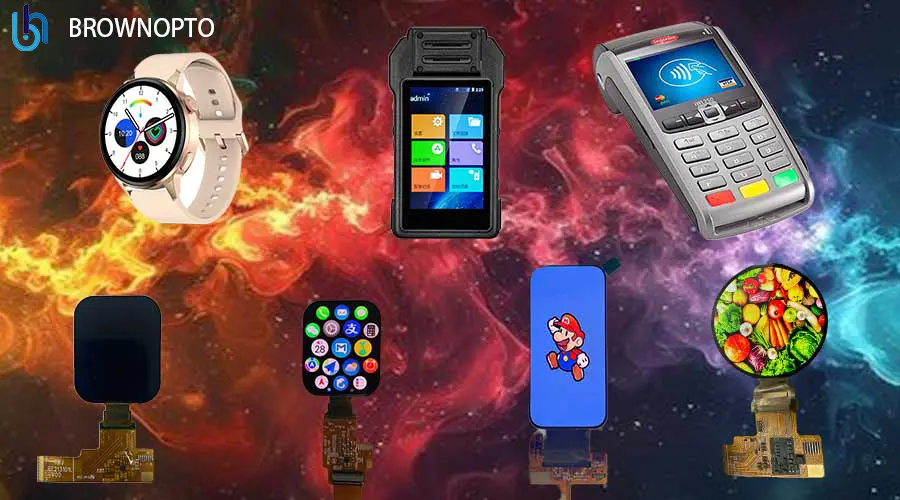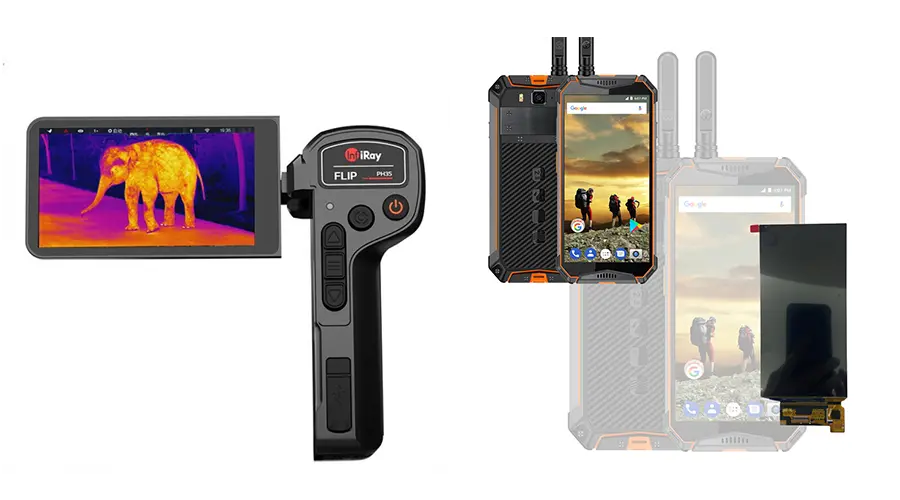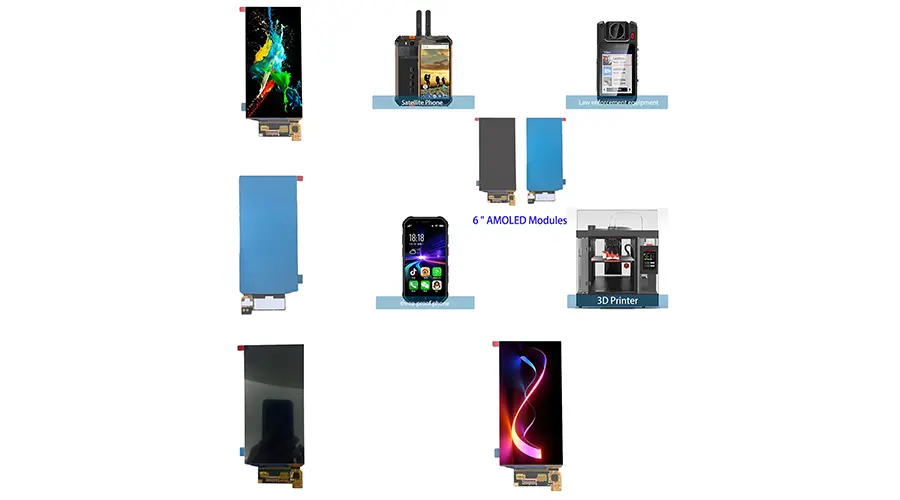A BROWNOPTO Engineering Case Study with MedTech Innovations Inc.
クライアント: MedTech Innovations Inc. — a U.S.-based innovator in point-of-care (POC) diagnostic systems
Application: Portable Blood Chemistry Analyzer for Emergency & Rural Healthcare
BROWNOPTO Product: Custom 4.40" On-Cell Touch LTPS AMOLED Display Module (Model: BR440102-A1)
インタフェース: MIPI DSI 2-lane, 60Hz refresh rate
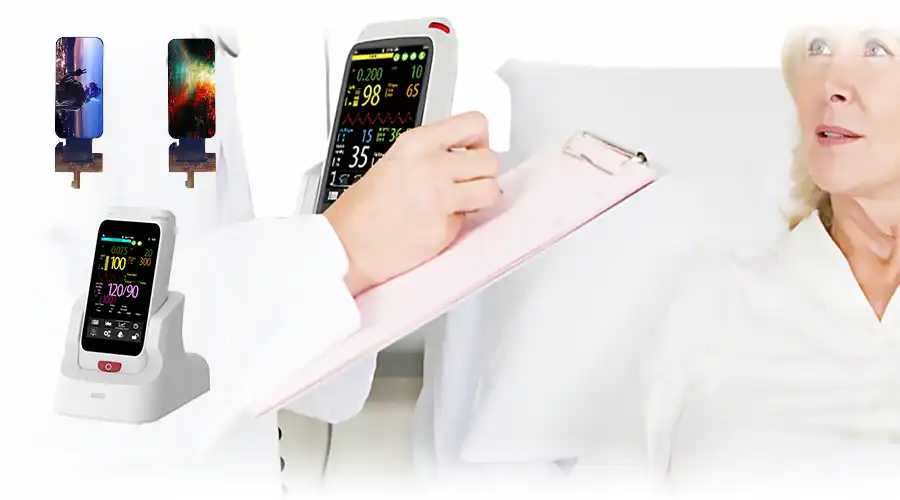
Project Background & Technical Challenges
MedTech Innovations sought to replace the legacy LCD in its flagship handheld blood analyzer with a next-generation display that could meet the stringent demands of clinical and field environments. The device is used by paramedics, lab technicians, and rural health workers—often in uncontrolled lighting, temperature, and humidity conditions.
コアディスプレイ要件は次のとおりです。
日光下での可読性:直射日光下(100,000 ルクス以上)でも読みやすいよう、反射防止(AR)加工を施した最低 600 nits の明るさを実現。
環境堅牢性:-20°C ~ +70°C の周囲温度および 95% の相対湿度 (結露なし) で安定した動作。
人的要因:濡れた指でも操作でき、遅延も少ない (<20 ミリ秒) 手袋対応の静電容量式タッチ。
フォームファクター:モジュールの厚さは ≤0.8 mm で、よりスリムで人間工学に基づいたハンドヘルド シャーシを実現します。
規制遵守:医療機器に関する RoHS 2.0 (2015/863/EU)、REACH (SVHC < 0.1%)、ハロゲンフリー (HF) 材料規格に完全に準拠しています。
長期的な信頼性:輝度の低下が最小限で、50,000 時間以上の動作寿命。
市販のAMOLEDパネルは、クラスII医療機器に求められる機械的耐久性と光学的安定性を満たしていませんでした。MedTechは、供給だけでなく共同開発も可能なディスプレイパートナーを必要としていました。
BROWNOPTOによる共同設計AMOLEDディスプレイソリューション
BROWNOPTOは、MedTechのハードウェアおよびファームウェアチームと6ヶ月間の共同開発プログラムを実施しました。この共同作業は、光学設計、機械的な統合、電気的な検証、そして規制文書の作成にまで及びました。
主要なエンジニアリングのマイルストーンは次のとおりです。
光学スタックの最適化:ハイブリッド HC (ハードコート) + AR 偏光子を統合し、耐傷性 (鉛筆硬度 3H 以上) を維持しながら表面反射率を 1.5% 未満に低減します。
オンセルタッチ統合:CST3530 タッチ コントローラー ファームウェアをカスタム チューニングして、5mm の手袋をはめた指の入力をサポートし、湿気や手のひらの接触による誤ったトリガーを排除します。
熱管理:熱サイクル中の剥離を防止するために、低熱膨張 FPC (フレキシブル プリント回路) を実装します。
電源シーケンス:起動時の画面のちらつきをなくすために、ディスプレイの電源オン/オフのタイミングを MedTech の PMIC と共同設計しました。
色調整:医療用 UI 要素 (警告アイコン、トレンド グラフなど) の正確なレンダリングを保証するために、工場でガンマとホワイト ポイントのキャリブレーション (D65、2.2 ガンマ) が実行されます。
技術仕様
| パラメータ | 仕様 | 検証標準 |
|---|---|---|
| 表示タイプ | 4.40インチ LTPS AMOLED | — |
| アクティブエリア | 54.3 × 115.8 mm | — |
| 解決 | 568 × 1210ピクセル(フルHD+) | ピクセル密度: 296 PPI |
| 輝度 | 600 nits(標準)、800 nits(ピーク) | ISO 13406-2に準拠して測定 |
| コントラスト比 | 100,000:1(標準) | 暗い場所でも無限 |
| タッチテクノロジー | オンセル容量性(CST3530 IC) | 10点マルチタッチをサポート |
| 視野角 | ≥85°(全方向) | 80°でΔE < 5 |
| モジュールの厚さ | 0.75 mm(FPCを除く) | — |
| インタフェース | MIPI DSI 2レーン、60 Hz | MIPIアライアンスv1.3に準拠 |
| 動作温度 | -20℃~+70℃ | IEC 60068-2-1 / -2-2 |
| 保管温度 | -30℃~+80℃ | — |
| コンプライアンス | RoHS 2.0、REACH、HF、ISO 10993-5(細胞毒性試験済み) | 完全な材料宣言が利用可能 |
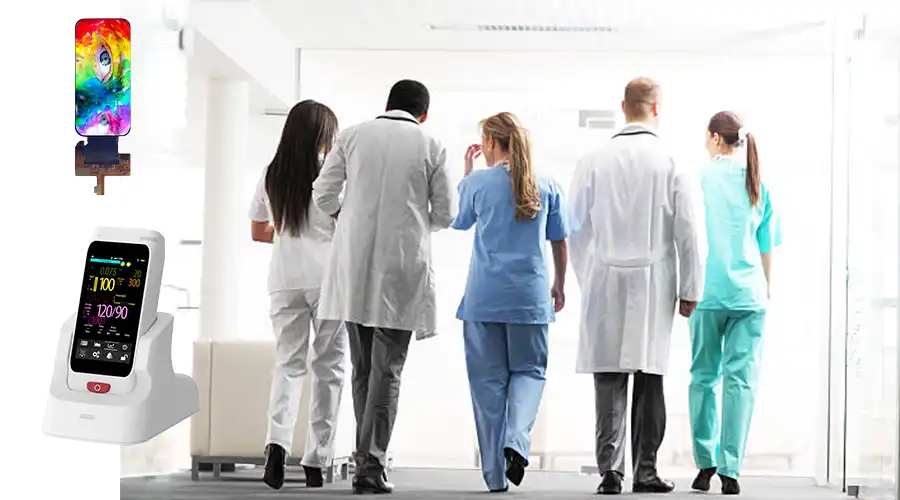
Validation & Field Performance
BR440102-A1 モジュールは、BROWNOPTO と MedTech の両施設で厳格な検証を受けました。
環境試験:240 時間の高温/低温サイクル (-20°C ↔ +70°C) および 96 時間の 95% RH 湿度暴露に合格しましたが、剥離やムラは発生しませんでした。
機械的堅牢性:1.2m から合板に 3 回落下しても機能障害は発生しませんでした (IEC 60601-1-11 準拠)。
光学的一貫性:パネル全体の輝度均一性は 85% 以上、視野角の変化による色の変化 (Δu'v') は 0.01 未満です。
臨床パイロット:12 か月間で米国の 12 の緊急医療サービス (EMS) 機関の 500 ユニットに導入され、ディスプレイ関連の現場での障害は報告されていません。
BROWNOPTOはディスプレイを納品しただけでなく、当社のNPIプロセスにも深く関わってくれました。彼らのエンジニアリングチームは、私たちが何ヶ月も苦労していたタッチノイズの問題を解決し、AMOLEDがFDAの材料トレーサビリティに関する文書要件を満たしていることを保証してくれました。このパートナーシップは、当社の製品発売に大きく貢献しました。
— MedTech Innovations Inc. の主任ハードウェア システム エンジニア
BROWNOPTO AMOLEDディスプレイが医療用途で優れている理由
BROWNOPTOのアプローチは、部品供給にとどまりません。ミッションクリティカルなアプリケーション向けに、エンドツーエンドのディスプレイエンジニアリングを提供します。
アプリケーションファースト設計:データシートの仕様だけでなく、実際の使用に合わせて設計されたディスプレイ。
垂直統合:社内での光学コーティング、タッチ統合、信頼性テスト。
規制サポート:医療機器申請のための完全な材料コンプライアンス文書 (RoHS、REACH、HF、ISO 10993)。
スケーラブルなNPI:試作から量産まで一貫した品質(PPM < 50)を実現します。
グローバルサポート:迅速な対応のためにアジア、北米、ヨーロッパにエンジニアリング チームを配置しています。
高信頼性の AMOLED ディスプレイを医療、産業、防衛機器に統合する準備はできていますか?
BROWNOPTOへのお問い合わせカスタム ディスプレイのコンサルティング - パフォーマンスを重視し、信頼性を重視して設計されています。
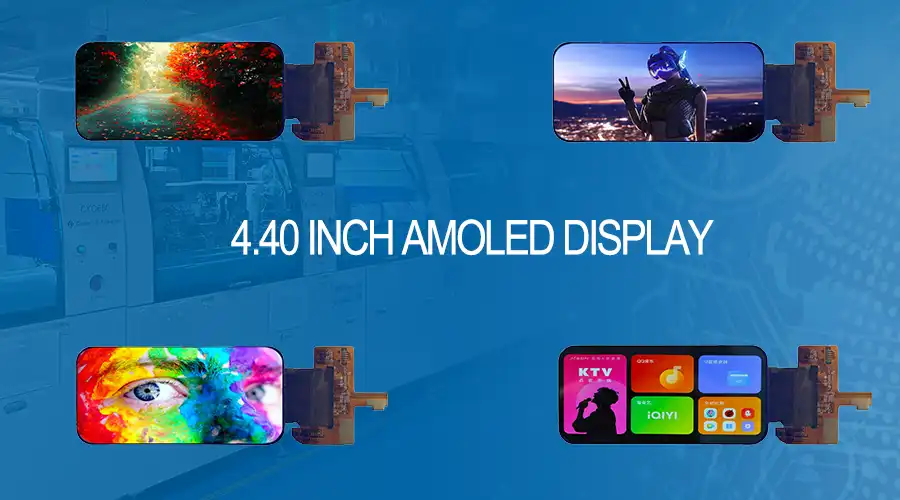
よくある質問
OLED の焼き付きの原因は何ですか? また、それを防ぐにはどうすればよいですか?
焼き付きは、静止画像を長時間表示することで有機材料が不均一に劣化することで発生します。焼き付きを防止するには、自動調光、画面タイムアウト、ピクセルシフト、ロゴの調光、静止コンテンツでの高輝度表示の回避などが挙げられます。
OLED ディスプレイは屋外や高輝度環境に適していますか?
標準的なOLEDはピーク輝度が低いため、直射日光下では見づらいです。しかし、一部のモデルはより高いnits出力と反射防止コーティングを備えています。屋外での使用には、ミニLEDまたは特殊な高輝度OLEDモデルをご検討ください。
OLED ディスプレイの寿命は通常どのくらいですか?
OLEDの寿命は、通常、L50(輝度半減)まで30,000~100,000時間とされています。寿命は使用パターン、輝度レベル、動作温度によって異なります。青色ピクセルは劣化が早いため、ホワイトバランスが時間の経過とともに変化する場合があります。
OLED は常時表示ディスプレイ (AOD) に使用できますか?
はい。OLEDは、ダークテーマや小さなアイコンを表示する際の消費電力が低いため、AODに最適です。焼き付きリスクを軽減するには、ダイナミックポジショニング、低輝度、アクティブピクセルの制限などの対策を講じてください。
AMOLED と PMOLED の違いは何ですか?
AMOLED(アクティブマトリックスOLED)は、TFTバックプレーンを採用することで高速リフレッシュと高解像度を実現し、スマートフォンやウェアラブル機器に最適です。PMOLED(パッシブマトリックスOLED)は行/列を直接駆動するため、小型でシンプルなディスプレイや低コストのディスプレイに適しています。
OLED ディスプレイはタッチ機能をサポートしていますか?
はい。ほとんどのOLEDモジュールには、静電容量式(PCAP)または抵抗膜式タッチ層が組み込まれています。フレキシブルOLEDは、ウェアラブルや車載機器のシームレスなデザインを実現するために、曲面タッチセンサーと組み合わせられることがよくあります。
最新記事
-
2025年のAR/XRにおいて1~2インチAMOLEDが鍵となる理由
AR/XRブームで1~2インチAMOLEDディスプレイが不可欠になる理由(2025年業界インサイト)body {f
-
Understanding OLED Display Technology: Principles, Performance & Applications
OLED (Organic Light Emitting Diode) displays are a class of self-emissive display technology in whic
-
From Wearables to AR Glasses – How OLED Displays Are Redefining Visual Experiences in 2025
By 2025, OLED (Organic Light-Emitting Diode) technology has transitioned from luxury smartphone disp
-
Stretched Bar LCD Displays for Retail: Boost Sales & Engagement in Supermarkets
ストレッチバーLCDディスプレイがスーパーマーケットの棚端マーケティングを強化し、売上を促進し、コストを削減する方法をご覧ください。
-
Stretched LCD Solutions for Restaurants and Hospitality Venues
ストレッチLCDは、レストランのメニューやホスピタリティサービスに最適な、洗練された高輝度ディスプレイを提供します。

